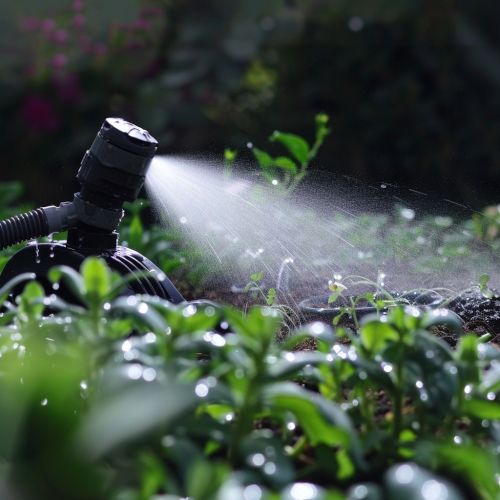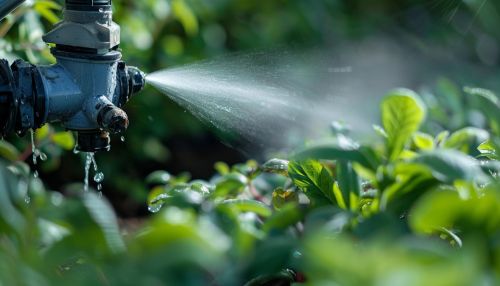Micro-spray irrigation
Introduction
Micro-spray irrigation is an advanced irrigation technique that utilizes small, low-pressure spray heads to deliver water directly to the root zones of plants. This method is particularly effective in conserving water and ensuring that plants receive the precise amount of moisture needed for optimal growth. Unlike traditional irrigation systems, micro-spray irrigation is designed to minimize water wastage and maximize efficiency, making it an ideal choice for both agricultural and landscape applications.
History and Development
The concept of micro-spray irrigation emerged in the mid-20th century as a response to the growing need for water conservation in agriculture. Early systems were rudimentary and often prone to clogging and inefficiency. However, advancements in materials and technology have led to the development of highly sophisticated micro-spray systems that are both durable and efficient. The introduction of plastic materials and precision engineering has significantly improved the reliability and performance of these systems.
Components of Micro-Spray Irrigation Systems
Micro-spray irrigation systems consist of several key components, each playing a crucial role in the overall functionality of the system. These components include:
Pump
The pump is responsible for supplying water to the irrigation system. It must be capable of maintaining the necessary pressure to ensure that water is evenly distributed through the spray heads.
Filters
Filters are essential for preventing debris and particulates from clogging the spray heads. Common types of filters used in micro-spray irrigation include screen filters and disc filters.
Pressure Regulators
Pressure regulators are used to maintain a consistent water pressure throughout the system. This is crucial for ensuring that each spray head delivers the correct amount of water.
Tubing
Tubing is used to transport water from the main supply line to the individual spray heads. It is typically made from durable, UV-resistant plastic materials.
Spray Heads
Spray heads are the components that deliver water to the plants. They are designed to produce a fine mist or spray, which helps to evenly distribute water over the root zone. There are various types of spray heads available, including fixed spray heads, adjustable spray heads, and rotating spray heads.


Advantages of Micro-Spray Irrigation
Micro-spray irrigation offers several advantages over traditional irrigation methods:
Water Conservation
One of the primary benefits of micro-spray irrigation is its ability to conserve water. By delivering water directly to the root zone, this method minimizes evaporation and runoff, ensuring that more water is used by the plants.
Improved Plant Health
Micro-spray irrigation provides a consistent and controlled water supply, which can lead to healthier plants. The fine mist produced by the spray heads helps to maintain optimal soil moisture levels, reducing the risk of overwatering or underwatering.
Flexibility
Micro-spray irrigation systems are highly flexible and can be easily adapted to suit a wide range of applications. They can be used in both small gardens and large agricultural fields, and can be customized to meet the specific needs of different plants.
Reduced Labor
Once installed, micro-spray irrigation systems require minimal maintenance and can operate automatically. This reduces the need for manual watering and allows farmers and gardeners to focus on other tasks.
Applications of Micro-Spray Irrigation
Micro-spray irrigation is used in a variety of applications, including:
Agriculture
In agriculture, micro-spray irrigation is used to water crops such as vegetables, fruits, and flowers. It is particularly effective in areas with limited water resources, as it helps to maximize water use efficiency.
Landscaping
Micro-spray irrigation is also commonly used in landscaping to water lawns, gardens, and ornamental plants. Its ability to deliver water precisely where it is needed makes it an ideal choice for maintaining healthy and attractive landscapes.
Greenhouses
In greenhouses, micro-spray irrigation systems are used to create a controlled environment for growing plants. The fine mist produced by the spray heads helps to maintain the humidity levels needed for optimal plant growth.
Installation and Maintenance
Installation
Installing a micro-spray irrigation system involves several steps, including planning, selecting components, and setting up the system. Proper planning is essential to ensure that the system meets the specific needs of the plants and the layout of the area to be irrigated. Components must be carefully selected to match the water pressure and flow requirements of the system. The installation process typically involves laying out the tubing, attaching the spray heads, and connecting the system to a water source.
Maintenance
Regular maintenance is crucial for ensuring the long-term performance of a micro-spray irrigation system. This includes checking for leaks, cleaning filters, and inspecting spray heads for clogs or damage. Periodic adjustments may also be needed to ensure that the spray heads are delivering water evenly.
Challenges and Limitations
While micro-spray irrigation offers many benefits, it also has some challenges and limitations:
Initial Cost
The initial cost of installing a micro-spray irrigation system can be higher than other irrigation methods. However, the long-term savings in water and labor can offset this initial investment.
Clogging
Spray heads and filters can become clogged with debris, which can reduce the efficiency of the system. Regular maintenance is essential to prevent clogging and ensure optimal performance.
Water Quality
The quality of the water used in micro-spray irrigation can affect the performance of the system. Water with high levels of particulates or dissolved minerals can cause clogging and damage to the components.
Future Trends in Micro-Spray Irrigation
The future of micro-spray irrigation is likely to be shaped by advancements in technology and increasing awareness of the need for water conservation. Some potential trends include:
Smart Irrigation Systems
The integration of smart technology into micro-spray irrigation systems is expected to become more common. Smart irrigation systems use sensors and automated controls to optimize water use based on real-time data, such as soil moisture levels and weather conditions.
Sustainable Materials
The development of sustainable materials for use in micro-spray irrigation systems is another potential trend. This includes the use of biodegradable plastics and other eco-friendly materials that reduce the environmental impact of irrigation systems.
Precision Agriculture
Micro-spray irrigation is likely to play a key role in the future of precision agriculture. By delivering water precisely where it is needed, this method can help to maximize crop yields and reduce the environmental impact of farming.
